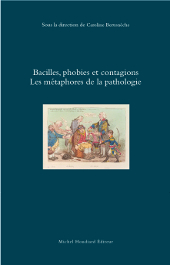- Imprimer
- Partager
- Partager sur Facebook
- Partager sur X
- Partager sur LinkedIn
Ouvrage / Recherche
La maladie nous obsède autant qu’elle nous fascine mais les écrivains ne lui accordent pas la place qu’elle mérite.
Il s’agit, selon Virginia Woolf, de combler un manque diagnostiqué, dans son essai De la maladie, comme une déficience logée au cœur du texte. Là où la pathologie peine à exister, la métaphore prolifère et multiplie les occurrences dans un parcours toujours polymorphe à travers les contrées, les genres, les classes et les siècles.
Héritée du travail de Susan Sontag sur le bacille de la tuberculose, sur le cancer ou encore le sida et les symboles qu’ils ont laissés derrière eux dans l’art et la société, cette exploration du concept de « pathologie » se veut macroscopique. L’étude des maladies et de leurs symptômes, bien sûr, s’étendant à la mise en mots, à la connaissance, par le langage, d’un organisme célébré pour son tissu infectieux que nous concevons, avant tout, comme un voyage : où et à quel moment le microbe a-t-il pris racine dans l’espace (littéraire) ?
Savoir localiser la maladie et pouvoir la nommer est déjà en soi une prouesse intellectuelle ; la faire exister ensuite revient à s’assurer que ses agents libres nous parviennent puis continuent à circuler – marche ou « démarche » vers le patient (le terme porte en lui la lenteur de ses attentes) qui inclut une réalité maintes fois contournée par la réécriture de sa mythologie.
Telle est la genèse d’une réflexion fluide dans ce recueil d’articles dédié à l’anatomie de l’humain aux prises avec le mal, les impuissances de son esprit encadrées par les douleurs de son histoire. Susan Sontag, à qui nous rendons ici hommage pour la persévérance de son engagement face au dédale de la pathologie, en théorie comme en pratique, nous ouvre une fois encore la voie en nous permettant d’injecter, au-delà du « phantasme », un mouvement autre à ce « paysage » devenu bien statique.
Illness is clearly a source of both obsession and fascination in all of us and yet writers do not seem to have given it the literary status it deserves. In her essay, On Illness, Virginia Woolf tells us that such is the tear that needs to be repaired within the textual body. Her diagnosis is almost tantamount to a deficiency in the way she envisions the failings of literature. If pathology struggles to exist properly in the reader’s consciousness, the metaphors associated to it proliferate quite freely and multiply in a larger conception of art where countries, genres, classes and centuries all eventually meet. Prompted by Susan Sontag’s reflection on tuberculosis, cancer, or even aids, and the symbols they have left behind in art and society, this exploration on the concept of “pathology” admits to a somewhat macroscopic ambition – the study of illnesses, of course, which extends to general modes of knowledge and their application to language. In other words, how should we address the problem of an organism celebrated for its infectious tissues? An exploration indeed, almost a voyage urging us to ask yet another question: when did microbes begin to migrate into certain areas of the literary canon? To be able to name and locate a disease is already as such an intellectual tour de force; to then be able to will the disease into existence and allow her free agents to be artfully integrated into our modes of thinking and understanding is even more miraculous – it is a patient (‘s) objective (the word “patient” itself condemns our impatience to a very slow process). This includes a medical reality oftentimes modified by a widely popular mythology. Such is the essence of a fluid articulation which brings together, in this volume, different essays on the subject, ranging from the human anatomy of art to a more metaphorical depiction of science. The portrait of an illness often speaks the truth and we should take the picture of medicine as it is drawn by the authors quite literally: an attempt to theorize pain by rewriting its symptoms, by inventing other ways to look at it when the mind’s impotencies are thus “framed” by the ekphrastics of its pathological history. Susan Sontag, to whom we must pay tribute for the persistence of her struggle for and against the pangs of pathology, in theory and in practice, opens up once again for the modern reader a new array of perspectives. Urging us to look under the veil of an illness’s own set of fantasies, she allows us to inject other forms of creative movements into the world of diseases and its rather static “scenery”.
Contributeurs :
Jean-Pierre Naugrette (Paris 3), Élodie Raimbault (Grenoble 3), Catherine Delmas (Grenoble 3), Sébastien Scarpa (Grenoble 3), Caroline Bertonèche (Grenoble 3), Marianne Drugeon (Montpellier 3), Marie-Céline Daniel (Paris IV), Alexandra Sippel (Toulouse 2), Johann Chapoutot (Grenoble 2/IUF), Sylvie Kleiman-Lafon (Paris 8), Sophie Laniel-Musitelli (Lille 3), Delphine Cadwallader-Bouron (Paris 3), Gaëtane Plottier (Grenoble 2), Benjamine Toussaint (Paris IV), Laure de Nervaux-Gavoty (Paris-Est Créteil).
Sous la direction de Caroline Bertonèche.
En savoir plus
Auteur(s) :Caroline Bertonèche
Date de publication :
Pages : 266

- Imprimer
- Partager
- Partager sur Facebook
- Partager sur X
- Partager sur LinkedIn